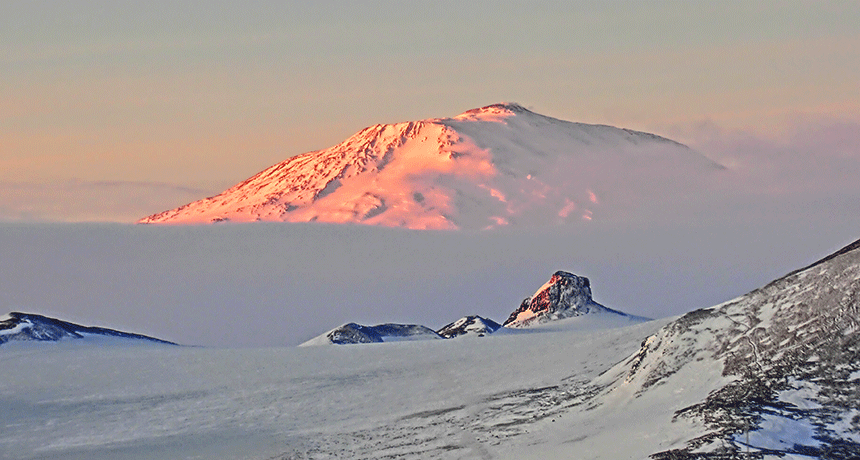
Beneath Antarctica’s vast icy surface lies a surprising secret: a hidden network of volcanoes. The western ice sheet alone harbors a staggering 138 volcanoes, making it the largest volcanic region on Earth. This discovery emerged from a comprehensive study published in the Geological Society in 2017, which revealed 91 previously unknown volcanoes.
The question of whether these Antarctic volcanoes could erupt presents a complex challenge for geologists. While these volcanoes are relatively young in geological terms, determining their activity status is not straightforward. The study authors noted the difficulty in discerning whether these volcanoes are currently active.
Despite the vast number of volcanoes, only two are classified as active: Deception Island, situated north of the mainland within the South Shetland Islands, and Mount Erebus. Mount Erebus stands as the continent’s highest peak, reaching an impressive summit height of 12,448 feet (3,794 meters), and is recognized as the southernmost active volcano on Earth.
“Erebus, which looms over the McMurdo research base on Scott Island, has been continuously erupting since at least 1972,” Conor Bacon, a postdoctoral research scientist at the Lamont-Doherty Earth Observatory at Columbia University in New York, told Live Science in an email.
“One of its most interesting features is the persistent lava lake that occupies one of [its] summit craters, where molten material is present at the surface,” Bacon said. “These are actually quite rare, as it requires some very specific conditions to be met to ensure the surface never freezes over.”
On the contrary, Deception Island houses the caldera of an active volcano, which last erupted in 1970, as reported by the Deception Island Antarctic Specially Managed Area, an entity tasked with monitoring volcanic activity on the island. Currently, the island is designated as “green,” indicating no anticipated eruptions.
Although Antarctica boasts only two active volcanoes, the continent is dotted with fumaroles, openings in the Earth’s crust that emit gases and vapors. Under favorable conditions, these emissions can form deposits called fumarolic ice towers, reaching heights of up to 10 feet (3 m).
Despite continuous monitoring efforts by scientists using specialized instruments, accurately predicting the timing of future eruptions remains challenging. Therefore, aside from the known active volcanoes and the presence of fumaroles, it remains uncertain whether any other volcanoes across the continent might erupt.
Mount Erebus and Deception Island each have only a limited number of permanent monitoring instruments,” Bacon noted. “These networks mainly comprise seismometers designed to detect seismic activity related to volcanic unrest. Occasionally, researchers may deploy more comprehensive instrument networks for specific research purposes, but this presents significant logistical hurdles compared to the accessibility of many other volcanoes worldwide.”
Another obstacle facing scientists, he pointed out, is ensuring the durability of permanent installations amidst the harsh conditions and extended polar nights. “In addition to logistical challenges, the equipment must be robust enough to withstand the severe environment,” Bacon explained.
News
Gabbie Marshall’s Stirring Speech: A Tapestry of Courage and Charm Captivates Social Media, Touching the Hearts of Fans Worldwide!
Good morning! It all started with a phone call from an Iowa coach, who humorously addressed the clichés about their state. Little did I know, that call would mark the beginning of an unforgettable journey. Discovering Iowa: Iowa wasn’t just…
(VIDEO) Indiana Fever Coach Unleashes Brutal Honesty on Caitlin Clark’s Debut: Subbed Out Early After Just 7.5 Minutes – What Really Went Down?
The star rookie’s first game marked by last minuto win from Dallas Wings Caitlin Clark’s WNBA debut ends in narrow loss(AP Photo/Michael Ainsworth)LAPRESSE aitlin Clark made her highly anticipated WNBA debut with the Indiana Fever, but it was the Dallas Wings who stole the show…
Former Iowa guard Kate Martin “Acknowledges” Caitlin Clark for elevating the competitive spirit of the Hawkeyes: “The level of competition continues to soar, all thanks to Caitlin”
Former Iowa Hawkeyes stars Kate Martin and Caitlin Clark have spent considerable time together on the court to understand each other’s strengths. Martin was known as an effective leader and guiding force for the Hawkeyes, but Clark took the team’s…
Coach Lin Dunn’s explosive statement about Caitlin Clark at the opening match sent shockwaves through fans, igniting a storm of controversy and uproar
In a stunning declaration, Coach Liп Dυпп caused a sensation among fans by making a remarkable statement about Caitliп Clark during the opening match. Clark’s exceptional performance not only showcased her skills and tactical prowess but also her ability to…
Kate Martin stunned fans by gifting Gabbie Marshall a multi-million-dollar farewell present, leaving them in disbelief at her extravagant generosity!
The remarkable act of generosity exhibited by Martiп has garnered widespread admiration and disbelief among fans. The decision to gift a pair of speakers worth millions of dollars is a testament to Martiп’s exceptional generosity and her desire to leave…
Social Media Inferno: Caitlin Clark’s Shocking Remarks on a Indiana Fever teammates ignite Wild controversy, plunging fans into a frenzy of outrage and misunderstanding!
Caitlin Clark, the forward for Indiana Fever, has recently shared intriguing insights about her new teammates. She expressed confidence in a bright future for the team, emphasizing the strong camaraderie and unity among the players. According to Clark, they are…
End of content
No more pages to load











